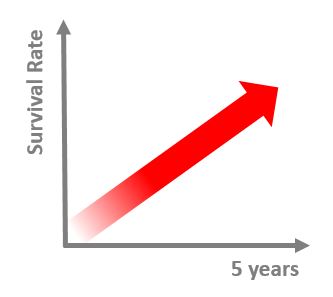Hope for people with leukemia

Data recently released by Statistics Canada provide some hope for both adolescent and adult Canadians who have leukemia. Clear progress in therapy for this type of cancer, such as increasingly effective cellular therapies, is most likely one of the reasons for these positive gains.
Recently published data (which excluded Quebec due to difficulty comparing this province’s data) clearly show that the five-year relative survival ratios for adolescents and adults diagnosed with leukemia in Canada improved more compared to almost any other type of cancer from 1992 to 2008. The increase in survival varied depending on the type of leukemia.
This new study is based on data from the Canadian Cancer Registry and gives a clearer picture of the historical increase in survival rates.
One fact that has emerged from the data is that chronic lymphocytic leukemia accounts for more than 4 out of 10 new leukemia cases.
Chronic lymphocytic leukemia is a cancer that starts in blood stem cells. Stem cells are basic cells that can develop into different types of cells with different jobs. As the stem cells of the blood develop, they become blast cells (blasts), which are immature blood cells. In leukemia, there is an overproduction of blast cells. These blast cells develop abnormally and don’t develop into mature blood cells. Over time, the blast cells crowd out normal blood cells so that they can’t do their jobs. When leukemia is diagnosed, these blast cells may be called leukemia cells.
(Source: Canadian Cancer Society)
A detailed portrait
Each year, leukemia accounts for 3% of all new primary cancers in Canada. From 1992 to 2008, the type of leukemia most commonly diagnosed in adolescents and adults was chronic lymphocytic (44.1% of cases), followed by acute myeloid (24.3%), chronic myeloid (12.3%) and acute lymphocytic (4.6%).
A particularly striking fact is that chronic myeloid leukemia had the highest gain in survival rates.
Chronic myeloid leukemia (CML) starts in abnormal myeloid stem cells and develops slowly. The abnormal myeloid stem cells develop into cancerous, or malignant, granulocytes. CML rarely develops in children and is one of the less common types of leukemia in adults. About 95% of adults with CML have the Philadelphia (Ph) chromosome in their leukemia cells. This is an acquired chromosomal abnormality, which means that it occurs at some time after birth.
(Source: Canadian Cancer Society)
Gains in survival rates for all types of leukemia
Five-year survival rates have increased for the four main types of leukemia. Chronic myeloid leukemia had the biggest increase with 24.9 percentage points, while acute lymphocytic leukemia was associated with the second biggest gain. The five-year survival rates for all leukemias combined increased from 45.7% to 57.5%.
Gender and age
These improvements in survival time were found for both men and women; however, women have a significant survival advantage over men for all leukemias combined. The substantial gains in survival associated with chronic myeloid leukemia were evident in each of the five age groups considered. In particular, five-year survival increased from 46.1% to 87.5% among people diagnosed at ages 45 to 54. For chronic lymphocytic leukemia, improvements in survival were greatest at age 65 or older. In contrast, for acute myeloid leukemia, the largest improvements ? just over 20 percentage points ? were found among people in the 15-to-44 and 45-to-54 age groups.
How did we achieve these gains?
The study did not go into detail about the reasons for these encouraging results for people who have received a diagnosis of leukemia. However, a link was made to advancements in treatment and increasingly effective and personalized therapies that combine chemotherapy, stem cell transplant techniques, and pediatric-based protocols for young adults. The CellCAN network is actively investigating these new ultra-targeted therapies that provide great hope that all forms of leukemia can be successfully treated one day.
Note: Cancer incidence data are from the October 2011 version of the Canadian Cancer Registry, with mortality follow-up to December 31, 2008 through record linkage to the Canadian Vital Statistics – Death Database and from information reported by the provincial/territorial cancer registries.
Sources of information: Statistics Canada and the Canadian Cancer Society.